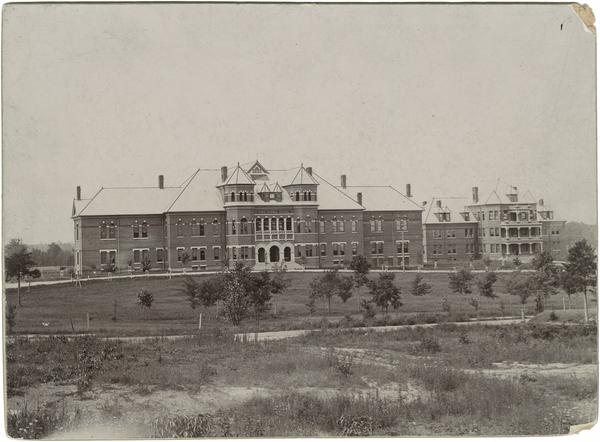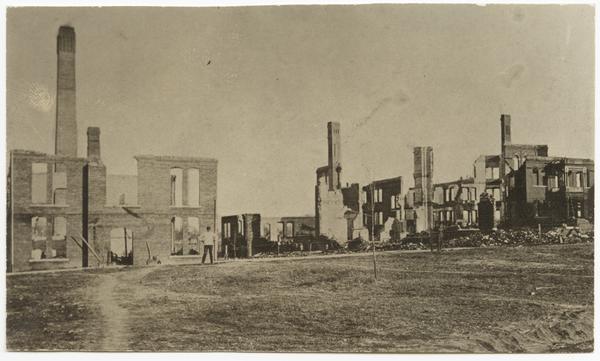The State Normal and Industrial College (now UNCG) faced a number of challenges in its infancy. An 1899-1900 typhoid fever outbreak killed 13 students and one staff member. Then, in the early hours of January 20, 1904, a massive fire consumed Brick Dormitory, one of the original campus buildings and the largest dormitory on campus.
Brick Dormitory, designed by Epps & Hackett of Greensboro, North Carolina, opened in 1892. Also known as the “matron’s hall” or the “living building,” the three-story structure was built in a number of stages. By 1895 a kitchen, infirmary room, and dining hall that held 150 students had been added. A final wing, including more dormitory rooms and larger dining and kitchen facilities, was added at the rear of the building by late 1903.
Around 3:45 am on that cold winter night, Eugene Osborne, the campus night watchman, discovered a fire and began evacuating residents. Faculty resident Minnie Jamison and students quickly alerted all of the 300+ residents. One student resident, Josephine Scott, ran outside in her nightgown to ring the college bell and sound the alarm until everyone was safely out of the building. Thanks to these alerts as well as previous fire drills, no lives were lost and no one was seriously injured in the evacuation. The dormitory building, however, was completely consumed, along with a nearby power plant and laundry building.
The residents of Brick Dormitory, while safe, lost almost all of their possessions. As Emma McKinney recounted, the residents were awakened with shouts of “Fire! … Don’t take time to get anything. Hurry.” She and her roommate, like most others, grabbed their robes and bedrooms slippers and rushed out of the building as quickly as possible.
Luckily, other students, faculty, townspeople, and residents from around the state were willing to assist the displaced students with offers of money, clothing, and spare rooms. McKinney recounted “the nice breakfast the different hotels sent out to the College” due to the fact that the kitchen was destroyed. Eventually a temporary shed was set up on the campus tennis courts (near the current Mary Foust Dormitory) to serve as a kitchen and dining hall. The Students’ Building, which was in use but not yet completed, was used as an emergency dormitory space, with sheets hung to form impromptu rooms.
President McIver, who was returning to campus from a trip to New York at the time of the fire, called a student assembly the following morning. There he had the students join in singing the hymn “Praise God from Whom All Blessings Flow.” He also expressed his sympathies for those who lost their possessions, along with his gratitude that no lives were lost. According to McKinney, “his talk was one never to be forgotten.”
The total loss due to the fire was evaluated at $64,458, and classes were suspended for three weeks. Within three days of the fire, however, the state legislature promised $80,000 for the construction of a new dormitory and McIver and the faculty began planning its features. The result of this was a two-story, very long building (492 feet) divided into fireproof sections. The new building would also house a dining hall. Construction began in April 1904 along College Avenue, and, in October, the dormitory — named for Cornelia Phillips Spencer — was completed.
Article by Erin Lawrimore


